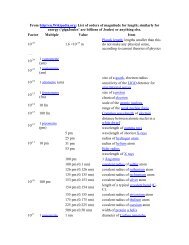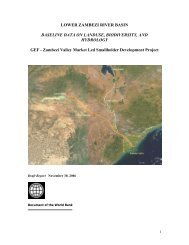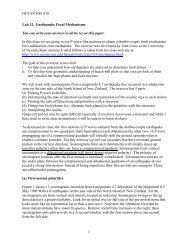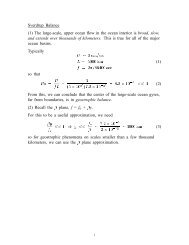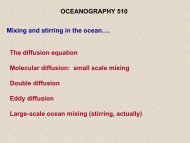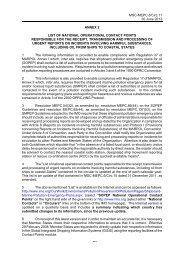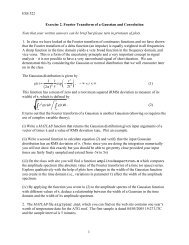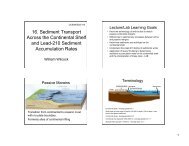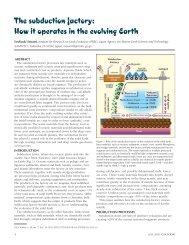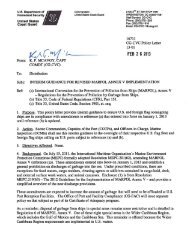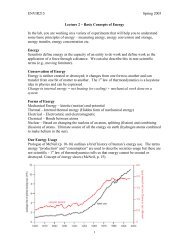2012 Seafloor Geodesy in Cascadia - William Wilcock - University of ...
2012 Seafloor Geodesy in Cascadia - William Wilcock - University of ...
2012 Seafloor Geodesy in Cascadia - William Wilcock - University of ...
You also want an ePaper? Increase the reach of your titles
YUMPU automatically turns print PDFs into web optimized ePapers that Google loves.
transponders and GPS is used to locate the ship and thus the position <strong>of</strong> the transponder <br />
network. Repeat campaign style measurements over several years can constra<strong>in</strong> plate <br />
motion (or the slip for any <strong>in</strong>terven<strong>in</strong>g earthquake). Because the ship must sit on station <br />
for several days to obta<strong>in</strong> a horizontal position with an accuracy <strong>of</strong> about a centimeter, the <br />
measurements are expensive and time consum<strong>in</strong>g. One approach to reduc<strong>in</strong>g costs is to <br />
use an alternative sea surface platform. Efforts are underway at SIO to develop systems <br />
that use an autonomous wave glider (an aquatic robot) for repeat campaign measurements <br />
or a moored buoy for cont<strong>in</strong>uous observations. In addition SIO and LDEO are develop<strong>in</strong>g a <br />
seafloor geodetic benchmark that simplifies the replacement <strong>of</strong> seafloor transponders <br />
when the batteries run out. <br />
Figure 6. GPS-‐acoustic methods can <br />
extend GPS observation <strong>of</strong>fshore <br />
(from Newman, 2011). <br />
An alternative approach to conventional <strong>of</strong>fshore GPS is the Geodetic Acoustic <br />
Benchmark Beacon Inverted EchoSounder (GABBIES) be<strong>in</strong>g developed at URI. In this <br />
method a s<strong>in</strong>gle acoustic beacon is located on the seafloor both horizontally and vertically <br />
by rang<strong>in</strong>g from two accurately navigated ship tracks that cross over the beacon. This <br />
method could also be adapted to cheaper autonomous unmanned surface vehicles. <br />
Vertical deformation <strong>of</strong> the seafloor is measured us<strong>in</strong>g absolute pressure gauges that <br />
are based on quartz stra<strong>in</strong> gauge technology. The Paroscientific Nano-‐Resolution Depth <br />
Sensors are capable <strong>of</strong> measur<strong>in</strong>g seafloor pressures with a resolution <strong>of</strong> 0.0001% and <br />
long-‐term drift rates as low as a few centimeters per year. These drift rates exceed the <br />
long-‐term signal (mm/yr) expected from stra<strong>in</strong> accumulation above the locked zone but <br />
would not obscure signals associated with many transient events. At Axial Seamount long <br />
term monitor<strong>in</strong>g <strong>of</strong> volcanic <strong>in</strong>flation with absolute pressure gauges has been comb<strong>in</strong>ed <br />
with campaign-‐style measurements us<strong>in</strong>g a mobile pressure recorder deployed from a <br />
remotely operated vehicle onto seafloor benchmarks to correct for differential drift <br />
between stations and obta<strong>in</strong> relative depth measurements with a repeatability <strong>of</strong> ~1 cm/yr <br />
(Chadwick et al., <strong>2012</strong>). The results document long-‐term uplift at ~15 cm/yr due to <br />
<strong>in</strong>flation <strong>of</strong> and deflation dur<strong>in</strong>g eruptions <strong>of</strong> up to 2-‐3 m over a week. A similar approach <br />
has been used on the East Pacific Rise and is planned for <strong>Cascadia</strong> subduction zone around <br />
13



